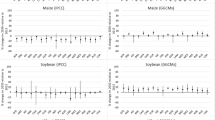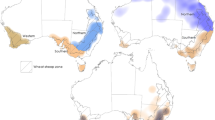Abstract
The purpose of the paper is to propose and test a new approach to simulating farmers' agronomic adaptation to climate change based on the pattern of adoption of technological innovation/substitution over time widely described as a S-shaped (or logistic) curve, i.e., slow growth at the beginning followed by accelerating and then decelerating growth, ultimately leading to saturation. The approach we developed is tested using the Erosion Productivity Impact Calculator crop model applied to corn production systems in the southeastern U.S. using a high-resolution climate change scenario. Corn is the most extensively grown crop in the southeastern U.S. The RegCM limited area model nested within the CSIRO general circulation model generated the scenario. We compare corn yield outcomes using this new form of adaptation (logistic) with climatically optimized (clairvoyant) adaptation. The results show logistic adaptation to be less effective than clairvoyant adaptation in ameliorating climate change impacts on yields, although the differences between the two sets of yields are statistically significant in one case only. These results are limited by the reliance on a single scenario of climate change. We conclude that the logistic technique should be tested widely across climate change scenarios, crop species, and geographic areas before a full evaluation of its effect on outcomes is possible.
Similar content being viewed by others
References
Brown, R. A. and Rosenberg, N. J.: 1999, 'Climate Change Impacts on the Potential Productivity of Corn and Winter Wheat in their Primary United States Growing Regions', Clim. Change 41, 73–107.
CAST: 1992, Preparing U.S. Agriculture for Global Climate Change, Council for Agricultural Science and Technology, Ames, Iowa.
Debecher, A. and Modis, T.: 1994, 'Determination of the Uncertainties in S-Curve Logistic Fits', Technological Forecasting and Social Change 46, 153–173.
Easterling, W. E.: 1996, 'Adapting North American Agriculture to Climate Change in Review', Agric. For. Meteorol. 80, 1–53.
Easterling, W. E., Crosson, P. R., Rosenberg, N. J., McKenney, M., Katz, L. A., and Lemon, K.: 1993, 'Agricultural Impacts of and Responses to Climate Change in theMissouri-Iowa-Nebraska-Kansas (MINK) Region', Clim. Change 24, 23–61.
Easterling, W. E., Mearns, L. O., Hays, C. J., and Marx, D.: 2001, 'Comparison of Agricultural Impacts of Climate Change Calculated from High and Low Resolution Climate Change Scenarios: Part II. Accounting for Adaptation and CO2 Direct Effects', Clim. Change 51, 173–197
Fisher, J. C. and Pry, R. H.: 1971, 'A Simple Substitution Model of Technological Change', Technological Forecasting and Social Change 3, 75–88.
Frederick, K. D and Schwarz. G.: 1999, 'Socioeconomic Impacts of Climate Change on U.S. Water Supplies', Journal of the American Water Resources Association 35, 1563–1583.
Geroski, P. A.: 2000, 'Models of Technology Diffusion', Research Policy 29, 603–625.
Gitay, H., Brown, S., Easterling, W. and Jallow, B. (with Antle, J., Apps, M., Beamish, R., Chapin, T., Cramer, W., Frangi, J., Laine, J., Lin Erda, L., Magnuson, J., Noble, I., Price, J., Prowse, T., Sirotenko, O., Root, T., Schulze, E., Sohngen, B., and Soussana, J.): 2001, 'Ecosystems and their Goods and Services', in McCarthy et al. (eds.), Climate Change 2001-Impacts, Adaptations and Mitigation of Climate Change: Scientific-Technical Analyses, Contribution of Working Group II to the Third Assessment Report of the Intergovernmental Panel on Climate Change, United Nations Environment Programme-World Meteorological Organization, Cambridge University Press, pp. 235–342.
Grübler, A.: 1998, Technology and Global Change, Cambridge University Press, Cambridge, pp. 50–75.
Harnett, D. L.: 1982, Statistical Methods, 3rd edn., Addison-Wesley Publishing Company, Inc.
Kaiser, H. M., Riha, S. J., Wilks, D. S., Rossier, D. G., and Sampath, R.: 1993, 'A Farm Level Analysis of Economic and Agronomic Impacts of Gradual Warming', Amer. J. Agric. Econ. 75, 387-398.
Kiniry, J. R, Jones, C. A., O'Toole, J. C., Blanchet, R., Cabeiguenne, M., and Spanel, D. A.: 1989, 'Radiation Use Efficiency in Biomass Accumulation Prior to Grain Filling in Five Grain-Crop Species', Field Crops Reasearch 20, 51–64.
Mansfield, E.: 1968, Industrial Research and Technological Innovation, W. W. Norton, New York.
Mearns, L. O., Giorgi, F., McDaniel, L., and Shields, C.: 2003, 'Climate Scenarios for the Southeastern U.S. Based on GCM and Regional Model Simulations', Clim. Change 60, 7–35.
Mearns, L. O., Easterling, W., Hays, C., and Marx, D.: 2001, 'Comparison of Agricultural Impacts of Climate Change Calculated from High and Low Resolution Climate Change Scenarios: Part I. The Uncertainty Due to Spatial Scale', Clim. Change 51, 131–172.
Parry, M. L., Carter, T. R., and Konijn, N. T. (eds.): 1988, The Impact of Climatic Variations on Agriculture, Kluwer, Dordrecht.
Reilly, J. M.: 1995, 'Climate Changes and Global Agriculture: Recent Findings and Issues', Amer. J. Agric. Econ. 77, 727–733.
Rosenberg, N. J.: 1982, 'The Increasing CO2 Concentration in the Atmosphere and its Implication on Agricultural Productivity: Part II. Effects through CO2-Induced Climatic Change', Clim. Change 4, 239–254.
Rosenzweig, C. and Parry, M.: 1994, 'Potential Impact of Climate Change on World Food Supply', Nature 367, 133–138.
Ruttan, V. W.: 1996, 'What Happened to Technology Adoption-Diffusion Research?', Sociologia Ruralis 36, 51–73.
Schneider, S. H., Easterling, W. E., and Mearns. L. O.: 2000, 'Adaptation: Sensitivity to Natural Variability, Agent Assumptions, and Dynamic Climate Changes', Clim. Change 45 (1), 203–221.
Smit, B., McNabb, D., and Smithers, J.: 1996, 'Agricultural Adaptation to Climate Variation', Clim. Change 33, 7–29.
Stockle, C. O., Williams, J. R., Rosenberg, N. J., and Jones, C. A.: 1992, 'A Method for Estimating Direct and Climatic Effects of Rising Atmospheric Carbon Dioxide on Growth Yield of Crops: Part I-Modification of the EPIC Model for Climate Change Analysis', Agricultural Systems 38, 225-228.
Williams, J. R., Jones, C. A., and Dyke, P. T.: 1984, 'A Modeling Approach to Determining the Relationship between Erosion and Soil Productivity', Trans. Am. Soc. Agric. Eng. 27, 129–144.
Williams, J. R., Jones, C. A., Kiniry, J. R., and Spaniel, D. A.: 1989, 'The EPIC Crop Growth Model', Trans. Am. Soc. Agric. Eng. 32, 497–511.
Yohe, G. W. and Schlesinger, M. E.: 1998, 'Sea Level Change: The Expected Economic Cost of Protection or Abandonment in the United States', Clim. Change 38, 447–472.
Author information
Authors and Affiliations
Rights and permissions
About this article
Cite this article
Easterling, W.E., Chhetri, N. & Niu, X. Improving the Realism of Modeling Agronomic Adaptation to Climate Change: Simulating Technological Substitution. Climatic Change 60, 149–173 (2003). https://doi.org/10.1023/A:1026023712494
Issue Date:
DOI: https://doi.org/10.1023/A:1026023712494




